Unit 187: Operations and Project Management Review and Critique Report
VerifiedAdded on 2023/06/08
|16
|5171
|384
Report
AI Summary
This report provides a comprehensive review and critique of the operations management principles implemented within Unilever Plc, a global consumer goods company. It begins with an introduction to Unilever, outlining its diverse product range and market presence, followed by a clear distinction between operations and operations management. The report then delves into a critical analysis of Unilever's application of key operations management principles, including reality, success, accountability, organization, and fundamentals. It assesses the extent to which Unilever's operations management meets organizational requirements, highlighting the benefits of adopting operational principles such as cost-effectiveness and customer satisfaction. Furthermore, the report explores the concept of continuous improvement as a philosophy, detailing the five lean principles and their relevance to Unilever's operations. Finally, it presents a continuous improvement plan with justified recommendations for enhancing Unilever's operations, based on the preceding review and critique. The report concludes with a summary of the key findings and recommendations, emphasizing the importance of operational efficiency and continuous improvement in maintaining a competitive edge in the consumer goods industry.

ID
Unit Number and Title Unit 187 –
Operations and
Project Management
Title Review and Critique
of Operations
Management (Part
1
Unit Number and Title Unit 187 –
Operations and
Project Management
Title Review and Critique
of Operations
Management (Part
1
Paraphrase This Document
Need a fresh take? Get an instant paraphrase of this document with our AI Paraphraser
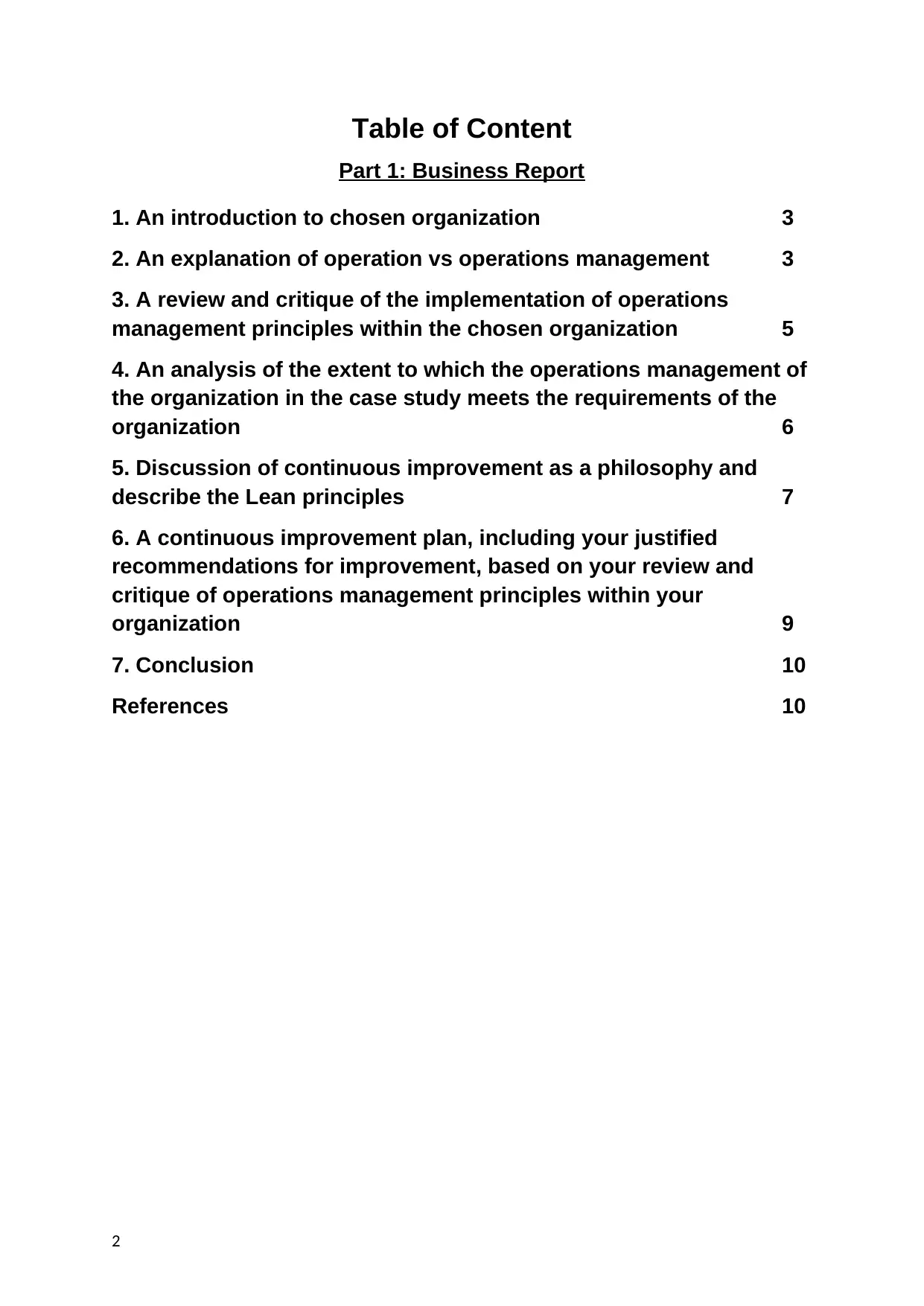
Table of Content
Part 1: Business Report
1. An introduction to chosen organization 3
2. An explanation of operation vs operations management 3
3. A review and critique of the implementation of operations
management principles within the chosen organization 5
4. An analysis of the extent to which the operations management of
the organization in the case study meets the requirements of the
organization 6
5. Discussion of continuous improvement as a philosophy and
describe the Lean principles 7
6. A continuous improvement plan, including your justified
recommendations for improvement, based on your review and
critique of operations management principles within your
organization 9
7. Conclusion 10
References 10
2
Part 1: Business Report
1. An introduction to chosen organization 3
2. An explanation of operation vs operations management 3
3. A review and critique of the implementation of operations
management principles within the chosen organization 5
4. An analysis of the extent to which the operations management of
the organization in the case study meets the requirements of the
organization 6
5. Discussion of continuous improvement as a philosophy and
describe the Lean principles 7
6. A continuous improvement plan, including your justified
recommendations for improvement, based on your review and
critique of operations management principles within your
organization 9
7. Conclusion 10
References 10
2
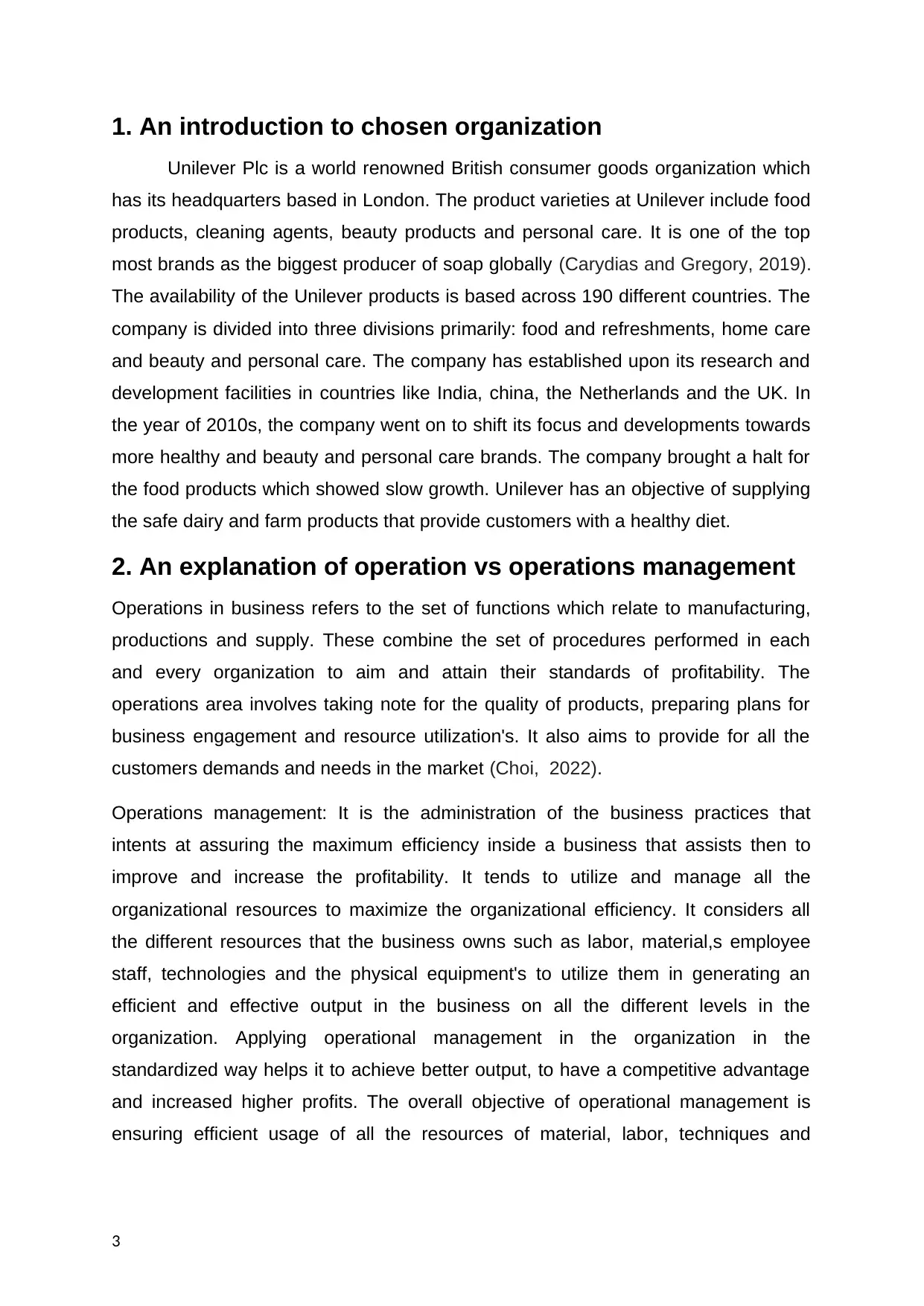
1. An introduction to chosen organization
Unilever Plc is a world renowned British consumer goods organization which
has its headquarters based in London. The product varieties at Unilever include food
products, cleaning agents, beauty products and personal care. It is one of the top
most brands as the biggest producer of soap globally (Carydias and Gregory, 2019).
The availability of the Unilever products is based across 190 different countries. The
company is divided into three divisions primarily: food and refreshments, home care
and beauty and personal care. The company has established upon its research and
development facilities in countries like India, china, the Netherlands and the UK. In
the year of 2010s, the company went on to shift its focus and developments towards
more healthy and beauty and personal care brands. The company brought a halt for
the food products which showed slow growth. Unilever has an objective of supplying
the safe dairy and farm products that provide customers with a healthy diet.
2. An explanation of operation vs operations management
Operations in business refers to the set of functions which relate to manufacturing,
productions and supply. These combine the set of procedures performed in each
and every organization to aim and attain their standards of profitability. The
operations area involves taking note for the quality of products, preparing plans for
business engagement and resource utilization's. It also aims to provide for all the
customers demands and needs in the market (Choi, 2022).
Operations management: It is the administration of the business practices that
intents at assuring the maximum efficiency inside a business that assists then to
improve and increase the profitability. It tends to utilize and manage all the
organizational resources to maximize the organizational efficiency. It considers all
the different resources that the business owns such as labor, material,s employee
staff, technologies and the physical equipment's to utilize them in generating an
efficient and effective output in the business on all the different levels in the
organization. Applying operational management in the organization in the
standardized way helps it to achieve better output, to have a competitive advantage
and increased higher profits. The overall objective of operational management is
ensuring efficient usage of all the resources of material, labor, techniques and
3
Unilever Plc is a world renowned British consumer goods organization which
has its headquarters based in London. The product varieties at Unilever include food
products, cleaning agents, beauty products and personal care. It is one of the top
most brands as the biggest producer of soap globally (Carydias and Gregory, 2019).
The availability of the Unilever products is based across 190 different countries. The
company is divided into three divisions primarily: food and refreshments, home care
and beauty and personal care. The company has established upon its research and
development facilities in countries like India, china, the Netherlands and the UK. In
the year of 2010s, the company went on to shift its focus and developments towards
more healthy and beauty and personal care brands. The company brought a halt for
the food products which showed slow growth. Unilever has an objective of supplying
the safe dairy and farm products that provide customers with a healthy diet.
2. An explanation of operation vs operations management
Operations in business refers to the set of functions which relate to manufacturing,
productions and supply. These combine the set of procedures performed in each
and every organization to aim and attain their standards of profitability. The
operations area involves taking note for the quality of products, preparing plans for
business engagement and resource utilization's. It also aims to provide for all the
customers demands and needs in the market (Choi, 2022).
Operations management: It is the administration of the business practices that
intents at assuring the maximum efficiency inside a business that assists then to
improve and increase the profitability. It tends to utilize and manage all the
organizational resources to maximize the organizational efficiency. It considers all
the different resources that the business owns such as labor, material,s employee
staff, technologies and the physical equipment's to utilize them in generating an
efficient and effective output in the business on all the different levels in the
organization. Applying operational management in the organization in the
standardized way helps it to achieve better output, to have a competitive advantage
and increased higher profits. The overall objective of operational management is
ensuring efficient usage of all the resources of material, labor, techniques and
3
⊘ This is a preview!⊘
Do you want full access?
Subscribe today to unlock all pages.

Trusted by 1+ million students worldwide

equipment's in order to make the organization able to match supply and sandman for
the products manufactured (Choi and et.al., 2022).
4
the products manufactured (Choi and et.al., 2022).
4
Paraphrase This Document
Need a fresh take? Get an instant paraphrase of this document with our AI Paraphraser

Operations Operations Management
Operations involves the daily
tasks relating to the daily
practices which are regarding
the development of any goods or
products of the business, the
management of sales and stock
materials in the business
(Gajadhar, Jordan and Stomski
Jr, 2018).
The Unilever in relation to its
operations of selling their
products and services in the
market to earn the business
revenue and profits in an
efficient manner.
Operations management entirely
connects to the tasks that include
managing and maintaining the
production efficiency in the
business. As the management of
operations provides the
organisation with the capability of
maintaining overall business
efficiency and the faults or issues,
if any that the management feels to
remove from the business.
For example, Unilever imparts
changes and modifications in its
products in any of the category that
they deal in utilising some better
usage of raw materials and labour
of the organisation. The usage of
better factors of production helps
the company to generate higher
revenues as compared to pervious
years.
3. A review and critique of the implementation of
operations management principles within the chosen
organization
Operations management principles: the operational management principles are an
essential tool that help the company to
1. Reality: The management of operations should aim to focus on the entire
problem and not just the tools or the techniques that are utilized. The reason
behind this issue is that no individual tool or techniques would help the
business in solving an entire set of problems and hence the organization
needs to look at the real situation and think for the solutions accordingly
(Gavião and et.al., 2019).
2. Success: The success of an organization can be computed and measured on
various basis depending upon the organizations objectives and targets. But
the most primary subject which is measured when calculating an
5
Operations involves the daily
tasks relating to the daily
practices which are regarding
the development of any goods or
products of the business, the
management of sales and stock
materials in the business
(Gajadhar, Jordan and Stomski
Jr, 2018).
The Unilever in relation to its
operations of selling their
products and services in the
market to earn the business
revenue and profits in an
efficient manner.
Operations management entirely
connects to the tasks that include
managing and maintaining the
production efficiency in the
business. As the management of
operations provides the
organisation with the capability of
maintaining overall business
efficiency and the faults or issues,
if any that the management feels to
remove from the business.
For example, Unilever imparts
changes and modifications in its
products in any of the category that
they deal in utilising some better
usage of raw materials and labour
of the organisation. The usage of
better factors of production helps
the company to generate higher
revenues as compared to pervious
years.
3. A review and critique of the implementation of
operations management principles within the chosen
organization
Operations management principles: the operational management principles are an
essential tool that help the company to
1. Reality: The management of operations should aim to focus on the entire
problem and not just the tools or the techniques that are utilized. The reason
behind this issue is that no individual tool or techniques would help the
business in solving an entire set of problems and hence the organization
needs to look at the real situation and think for the solutions accordingly
(Gavião and et.al., 2019).
2. Success: The success of an organization can be computed and measured on
various basis depending upon the organizations objectives and targets. But
the most primary subject which is measured when calculating an
5
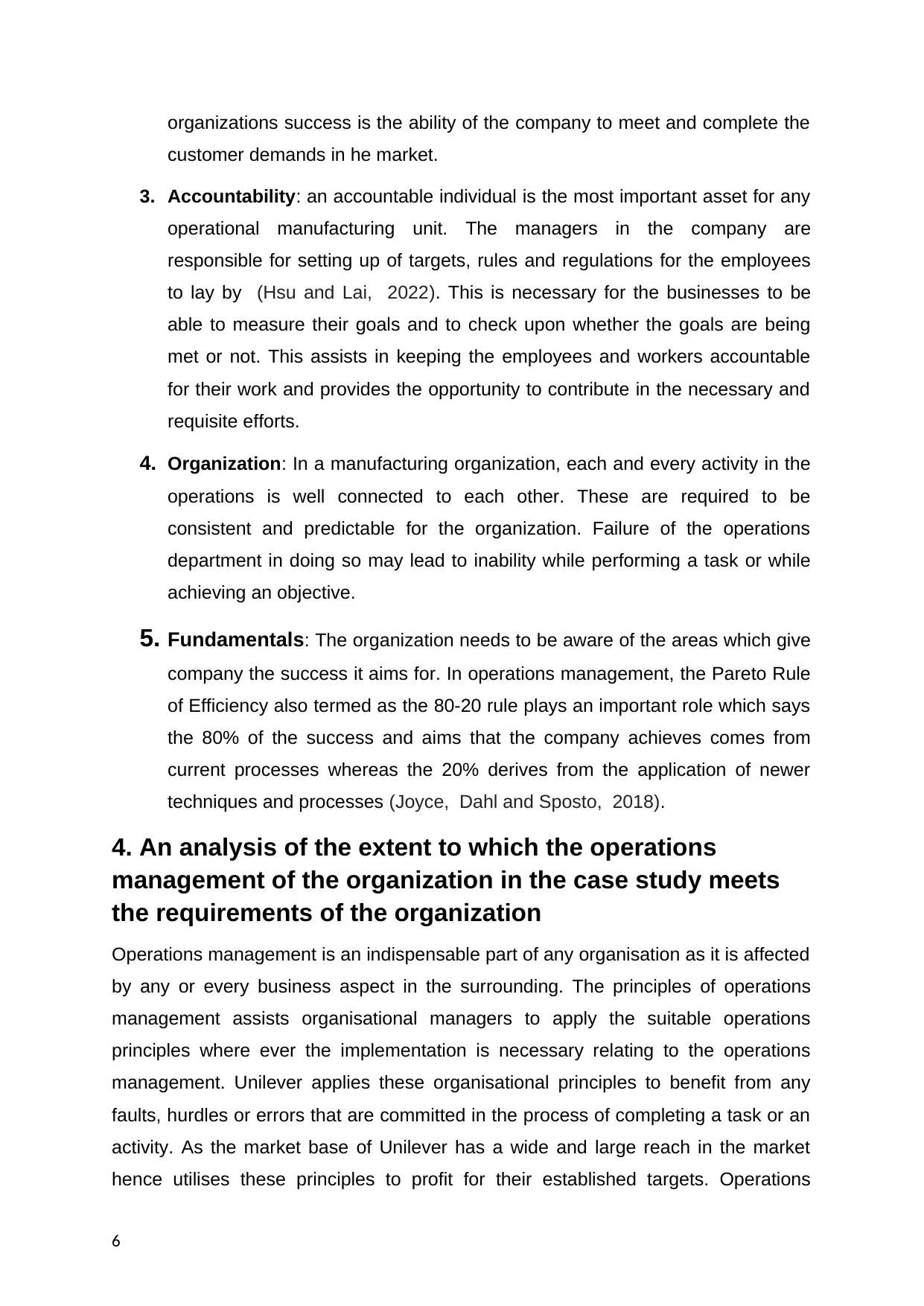
organizations success is the ability of the company to meet and complete the
customer demands in he market.
3. Accountability: an accountable individual is the most important asset for any
operational manufacturing unit. The managers in the company are
responsible for setting up of targets, rules and regulations for the employees
to lay by (Hsu and Lai, 2022). This is necessary for the businesses to be
able to measure their goals and to check upon whether the goals are being
met or not. This assists in keeping the employees and workers accountable
for their work and provides the opportunity to contribute in the necessary and
requisite efforts.
4. Organization: In a manufacturing organization, each and every activity in the
operations is well connected to each other. These are required to be
consistent and predictable for the organization. Failure of the operations
department in doing so may lead to inability while performing a task or while
achieving an objective.
5. Fundamentals: The organization needs to be aware of the areas which give
company the success it aims for. In operations management, the Pareto Rule
of Efficiency also termed as the 80-20 rule plays an important role which says
the 80% of the success and aims that the company achieves comes from
current processes whereas the 20% derives from the application of newer
techniques and processes (Joyce, Dahl and Sposto, 2018).
4. An analysis of the extent to which the operations
management of the organization in the case study meets
the requirements of the organization
Operations management is an indispensable part of any organisation as it is affected
by any or every business aspect in the surrounding. The principles of operations
management assists organisational managers to apply the suitable operations
principles where ever the implementation is necessary relating to the operations
management. Unilever applies these organisational principles to benefit from any
faults, hurdles or errors that are committed in the process of completing a task or an
activity. As the market base of Unilever has a wide and large reach in the market
hence utilises these principles to profit for their established targets. Operations
6
customer demands in he market.
3. Accountability: an accountable individual is the most important asset for any
operational manufacturing unit. The managers in the company are
responsible for setting up of targets, rules and regulations for the employees
to lay by (Hsu and Lai, 2022). This is necessary for the businesses to be
able to measure their goals and to check upon whether the goals are being
met or not. This assists in keeping the employees and workers accountable
for their work and provides the opportunity to contribute in the necessary and
requisite efforts.
4. Organization: In a manufacturing organization, each and every activity in the
operations is well connected to each other. These are required to be
consistent and predictable for the organization. Failure of the operations
department in doing so may lead to inability while performing a task or while
achieving an objective.
5. Fundamentals: The organization needs to be aware of the areas which give
company the success it aims for. In operations management, the Pareto Rule
of Efficiency also termed as the 80-20 rule plays an important role which says
the 80% of the success and aims that the company achieves comes from
current processes whereas the 20% derives from the application of newer
techniques and processes (Joyce, Dahl and Sposto, 2018).
4. An analysis of the extent to which the operations
management of the organization in the case study meets
the requirements of the organization
Operations management is an indispensable part of any organisation as it is affected
by any or every business aspect in the surrounding. The principles of operations
management assists organisational managers to apply the suitable operations
principles where ever the implementation is necessary relating to the operations
management. Unilever applies these organisational principles to benefit from any
faults, hurdles or errors that are committed in the process of completing a task or an
activity. As the market base of Unilever has a wide and large reach in the market
hence utilises these principles to profit for their established targets. Operations
6
⊘ This is a preview!⊘
Do you want full access?
Subscribe today to unlock all pages.

Trusted by 1+ million students worldwide

management is assisting various organisations and fulfilling the requirements of the
organisations and demands of customers in the following ways:
By adopting the operational management principles, Unilever has been
benefited upon in various ways in which it can benefit the customers by
providing them what they need in the form of most healthy and safer options
as compared to their previous productions and deliveries to their customers
(Kerzner, 2019). This will help the company in attracting larger bunch of their
customers as compared to their previous numbers as people are most health
and environment conscious in comparison to previous times.
Unilever applies the operational principles for implementing the cost effective
techniques to enable the company to provide customers with reasonable
prices for their varieties of products. The pricing of the company is reasonable
among all its competitors and it focuses on avoiding any unnecessary
purchases from customers side. This makes the customers o place loyalty
above all.
Unilever has a strong front when maintaining for their workplace environment
as it helps them in keeping the operations of the business in sync with other
processes at work. It also helps them to maintain quality control checks in
their operations. With the organisation having great relations with its suppliers
globally and availability of the raw materials with an easy access makes
Unilever able to utilise their operations, productions and sales at their best
capacity (Masmoudi, Jarboui and Siarry, 2021).
The principles of operations management enable Unilever to produce and
design the products according to market trends and requirements. It
necessarily shows that the organisation puts the customers as the top- most
priority with converting even window shoppers into a satisfied customer. It
shows that the business managers are able to look for the marketing trends
and analyse them to overline the products accordingly.
5. Discussion of continuous improvement as a philosophy
and describe the Lean principles
Continuous improvements are the that involve an ongoing Improvement and
betterment of the company products, services or the organizational processes of the
7
organisations and demands of customers in the following ways:
By adopting the operational management principles, Unilever has been
benefited upon in various ways in which it can benefit the customers by
providing them what they need in the form of most healthy and safer options
as compared to their previous productions and deliveries to their customers
(Kerzner, 2019). This will help the company in attracting larger bunch of their
customers as compared to their previous numbers as people are most health
and environment conscious in comparison to previous times.
Unilever applies the operational principles for implementing the cost effective
techniques to enable the company to provide customers with reasonable
prices for their varieties of products. The pricing of the company is reasonable
among all its competitors and it focuses on avoiding any unnecessary
purchases from customers side. This makes the customers o place loyalty
above all.
Unilever has a strong front when maintaining for their workplace environment
as it helps them in keeping the operations of the business in sync with other
processes at work. It also helps them to maintain quality control checks in
their operations. With the organisation having great relations with its suppliers
globally and availability of the raw materials with an easy access makes
Unilever able to utilise their operations, productions and sales at their best
capacity (Masmoudi, Jarboui and Siarry, 2021).
The principles of operations management enable Unilever to produce and
design the products according to market trends and requirements. It
necessarily shows that the organisation puts the customers as the top- most
priority with converting even window shoppers into a satisfied customer. It
shows that the business managers are able to look for the marketing trends
and analyse them to overline the products accordingly.
5. Discussion of continuous improvement as a philosophy
and describe the Lean principles
Continuous improvements are the that involve an ongoing Improvement and
betterment of the company products, services or the organizational processes of the
7
Paraphrase This Document
Need a fresh take? Get an instant paraphrase of this document with our AI Paraphraser
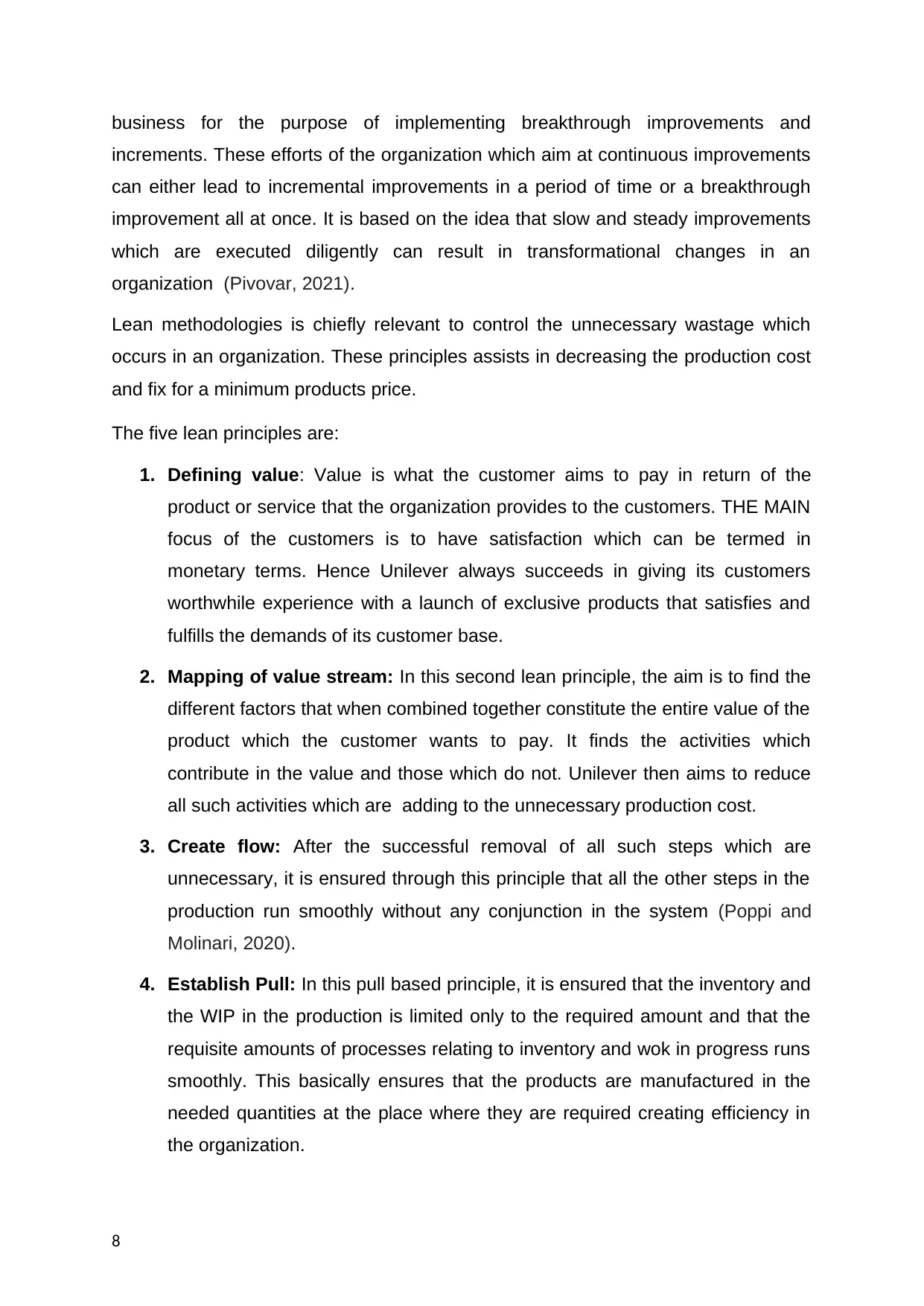
business for the purpose of implementing breakthrough improvements and
increments. These efforts of the organization which aim at continuous improvements
can either lead to incremental improvements in a period of time or a breakthrough
improvement all at once. It is based on the idea that slow and steady improvements
which are executed diligently can result in transformational changes in an
organization (Pivovar, 2021).
Lean methodologies is chiefly relevant to control the unnecessary wastage which
occurs in an organization. These principles assists in decreasing the production cost
and fix for a minimum products price.
The five lean principles are:
1. Defining value: Value is what the customer aims to pay in return of the
product or service that the organization provides to the customers. THE MAIN
focus of the customers is to have satisfaction which can be termed in
monetary terms. Hence Unilever always succeeds in giving its customers
worthwhile experience with a launch of exclusive products that satisfies and
fulfills the demands of its customer base.
2. Mapping of value stream: In this second lean principle, the aim is to find the
different factors that when combined together constitute the entire value of the
product which the customer wants to pay. It finds the activities which
contribute in the value and those which do not. Unilever then aims to reduce
all such activities which are adding to the unnecessary production cost.
3. Create flow: After the successful removal of all such steps which are
unnecessary, it is ensured through this principle that all the other steps in the
production run smoothly without any conjunction in the system (Poppi and
Molinari, 2020).
4. Establish Pull: In this pull based principle, it is ensured that the inventory and
the WIP in the production is limited only to the required amount and that the
requisite amounts of processes relating to inventory and wok in progress runs
smoothly. This basically ensures that the products are manufactured in the
needed quantities at the place where they are required creating efficiency in
the organization.
8
increments. These efforts of the organization which aim at continuous improvements
can either lead to incremental improvements in a period of time or a breakthrough
improvement all at once. It is based on the idea that slow and steady improvements
which are executed diligently can result in transformational changes in an
organization (Pivovar, 2021).
Lean methodologies is chiefly relevant to control the unnecessary wastage which
occurs in an organization. These principles assists in decreasing the production cost
and fix for a minimum products price.
The five lean principles are:
1. Defining value: Value is what the customer aims to pay in return of the
product or service that the organization provides to the customers. THE MAIN
focus of the customers is to have satisfaction which can be termed in
monetary terms. Hence Unilever always succeeds in giving its customers
worthwhile experience with a launch of exclusive products that satisfies and
fulfills the demands of its customer base.
2. Mapping of value stream: In this second lean principle, the aim is to find the
different factors that when combined together constitute the entire value of the
product which the customer wants to pay. It finds the activities which
contribute in the value and those which do not. Unilever then aims to reduce
all such activities which are adding to the unnecessary production cost.
3. Create flow: After the successful removal of all such steps which are
unnecessary, it is ensured through this principle that all the other steps in the
production run smoothly without any conjunction in the system (Poppi and
Molinari, 2020).
4. Establish Pull: In this pull based principle, it is ensured that the inventory and
the WIP in the production is limited only to the required amount and that the
requisite amounts of processes relating to inventory and wok in progress runs
smoothly. This basically ensures that the products are manufactured in the
needed quantities at the place where they are required creating efficiency in
the organization.
8
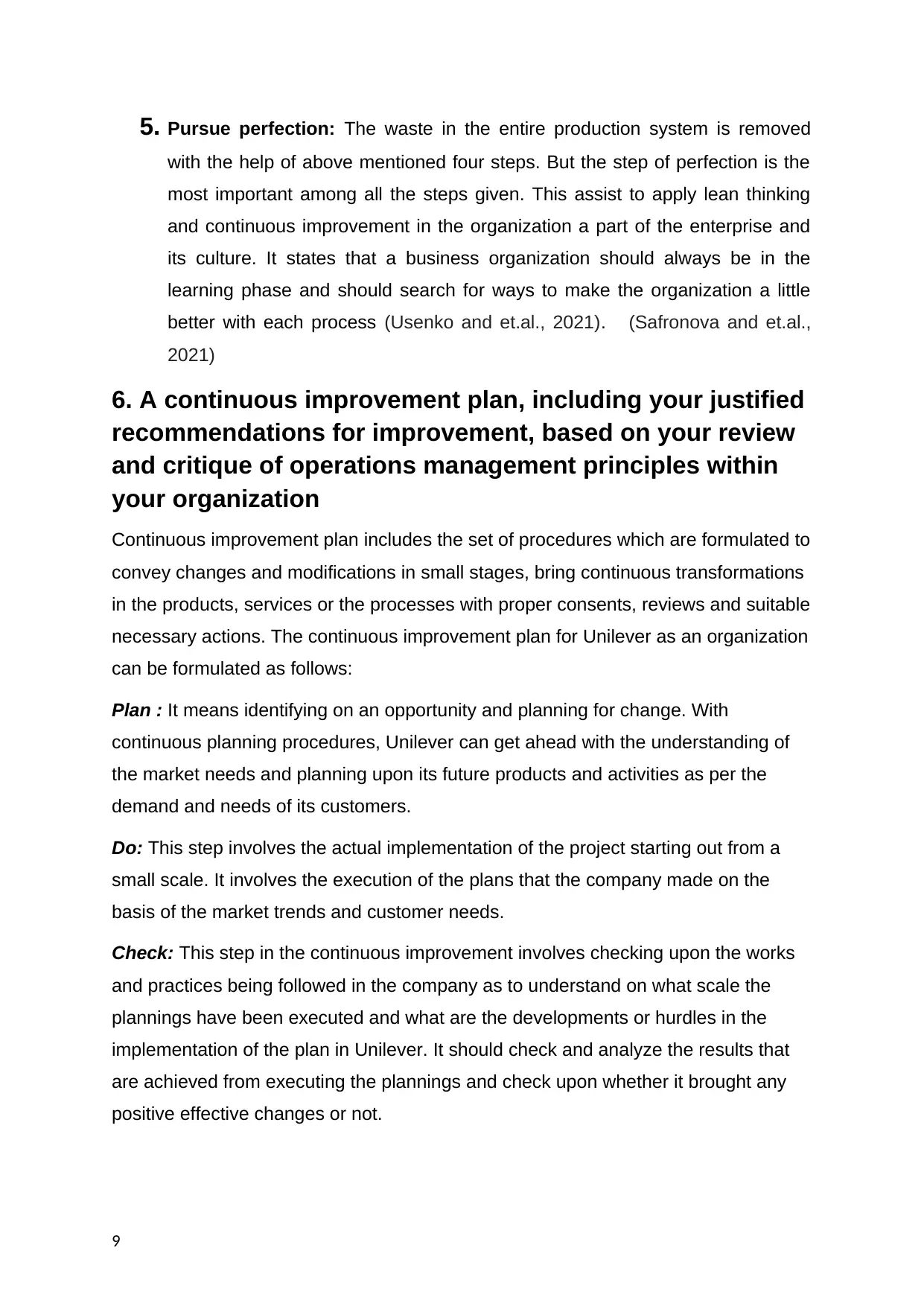
5. Pursue perfection: The waste in the entire production system is removed
with the help of above mentioned four steps. But the step of perfection is the
most important among all the steps given. This assist to apply lean thinking
and continuous improvement in the organization a part of the enterprise and
its culture. It states that a business organization should always be in the
learning phase and should search for ways to make the organization a little
better with each process (Usenko and et.al., 2021). (Safronova and et.al.,
2021)
6. A continuous improvement plan, including your justified
recommendations for improvement, based on your review
and critique of operations management principles within
your organization
Continuous improvement plan includes the set of procedures which are formulated to
convey changes and modifications in small stages, bring continuous transformations
in the products, services or the processes with proper consents, reviews and suitable
necessary actions. The continuous improvement plan for Unilever as an organization
can be formulated as follows:
Plan : It means identifying on an opportunity and planning for change. With
continuous planning procedures, Unilever can get ahead with the understanding of
the market needs and planning upon its future products and activities as per the
demand and needs of its customers.
Do: This step involves the actual implementation of the project starting out from a
small scale. It involves the execution of the plans that the company made on the
basis of the market trends and customer needs.
Check: This step in the continuous improvement involves checking upon the works
and practices being followed in the company as to understand on what scale the
plannings have been executed and what are the developments or hurdles in the
implementation of the plan in Unilever. It should check and analyze the results that
are achieved from executing the plannings and check upon whether it brought any
positive effective changes or not.
9
with the help of above mentioned four steps. But the step of perfection is the
most important among all the steps given. This assist to apply lean thinking
and continuous improvement in the organization a part of the enterprise and
its culture. It states that a business organization should always be in the
learning phase and should search for ways to make the organization a little
better with each process (Usenko and et.al., 2021). (Safronova and et.al.,
2021)
6. A continuous improvement plan, including your justified
recommendations for improvement, based on your review
and critique of operations management principles within
your organization
Continuous improvement plan includes the set of procedures which are formulated to
convey changes and modifications in small stages, bring continuous transformations
in the products, services or the processes with proper consents, reviews and suitable
necessary actions. The continuous improvement plan for Unilever as an organization
can be formulated as follows:
Plan : It means identifying on an opportunity and planning for change. With
continuous planning procedures, Unilever can get ahead with the understanding of
the market needs and planning upon its future products and activities as per the
demand and needs of its customers.
Do: This step involves the actual implementation of the project starting out from a
small scale. It involves the execution of the plans that the company made on the
basis of the market trends and customer needs.
Check: This step in the continuous improvement involves checking upon the works
and practices being followed in the company as to understand on what scale the
plannings have been executed and what are the developments or hurdles in the
implementation of the plan in Unilever. It should check and analyze the results that
are achieved from executing the plannings and check upon whether it brought any
positive effective changes or not.
9
⊘ This is a preview!⊘
Do you want full access?
Subscribe today to unlock all pages.

Trusted by 1+ million students worldwide
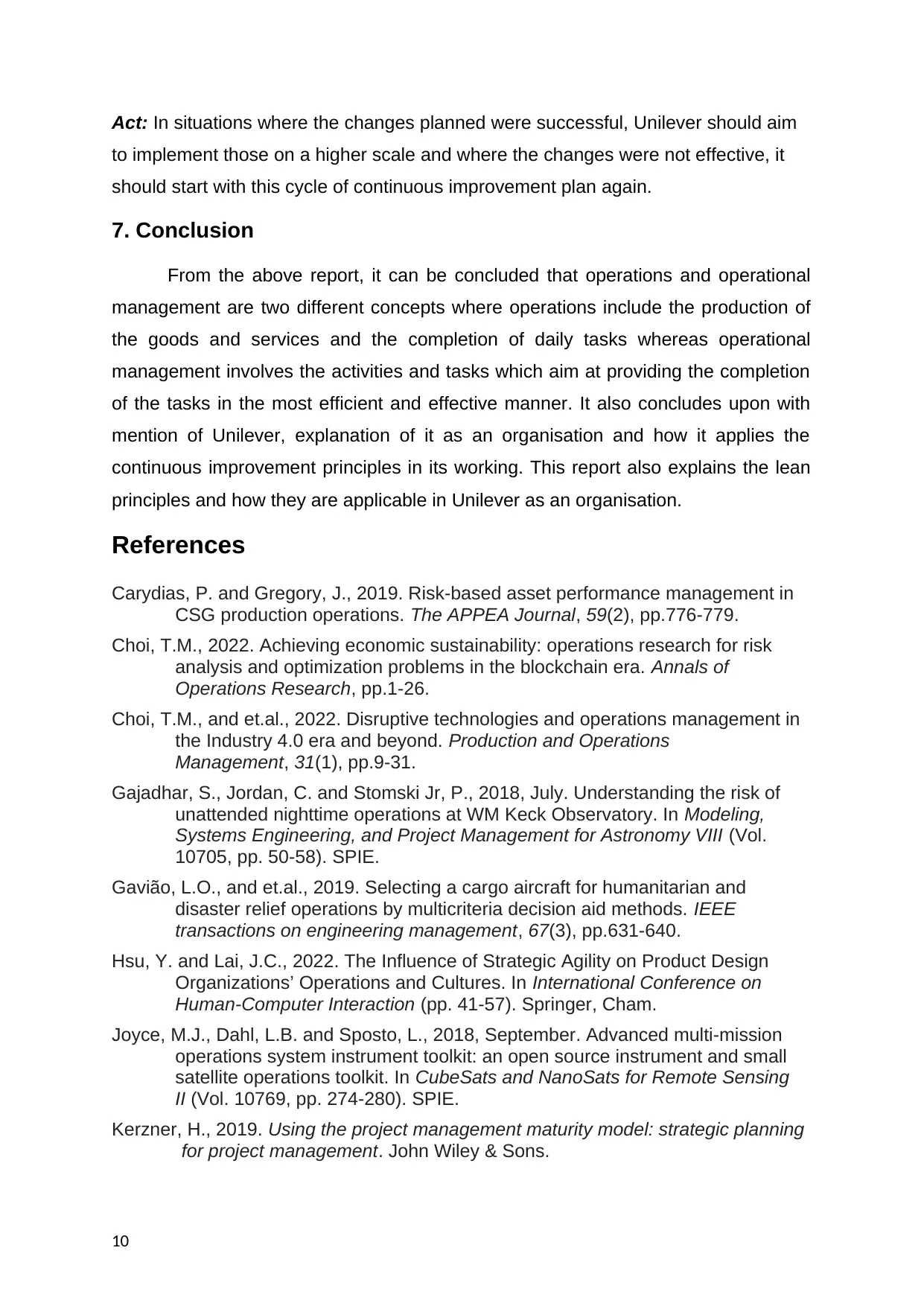
Act: In situations where the changes planned were successful, Unilever should aim
to implement those on a higher scale and where the changes were not effective, it
should start with this cycle of continuous improvement plan again.
7. Conclusion
From the above report, it can be concluded that operations and operational
management are two different concepts where operations include the production of
the goods and services and the completion of daily tasks whereas operational
management involves the activities and tasks which aim at providing the completion
of the tasks in the most efficient and effective manner. It also concludes upon with
mention of Unilever, explanation of it as an organisation and how it applies the
continuous improvement principles in its working. This report also explains the lean
principles and how they are applicable in Unilever as an organisation.
References
Carydias, P. and Gregory, J., 2019. Risk-based asset performance management in
CSG production operations. The APPEA Journal, 59(2), pp.776-779.
Choi, T.M., 2022. Achieving economic sustainability: operations research for risk
analysis and optimization problems in the blockchain era. Annals of
Operations Research, pp.1-26.
Choi, T.M., and et.al., 2022. Disruptive technologies and operations management in
the Industry 4.0 era and beyond. Production and Operations
Management, 31(1), pp.9-31.
Gajadhar, S., Jordan, C. and Stomski Jr, P., 2018, July. Understanding the risk of
unattended nighttime operations at WM Keck Observatory. In Modeling,
Systems Engineering, and Project Management for Astronomy VIII (Vol.
10705, pp. 50-58). SPIE.
Gavião, L.O., and et.al., 2019. Selecting a cargo aircraft for humanitarian and
disaster relief operations by multicriteria decision aid methods. IEEE
transactions on engineering management, 67(3), pp.631-640.
Hsu, Y. and Lai, J.C., 2022. The Influence of Strategic Agility on Product Design
Organizations’ Operations and Cultures. In International Conference on
Human-Computer Interaction (pp. 41-57). Springer, Cham.
Joyce, M.J., Dahl, L.B. and Sposto, L., 2018, September. Advanced multi-mission
operations system instrument toolkit: an open source instrument and small
satellite operations toolkit. In CubeSats and NanoSats for Remote Sensing
II (Vol. 10769, pp. 274-280). SPIE.
Kerzner, H., 2019. Using the project management maturity model: strategic planning
for project management. John Wiley & Sons.
10
to implement those on a higher scale and where the changes were not effective, it
should start with this cycle of continuous improvement plan again.
7. Conclusion
From the above report, it can be concluded that operations and operational
management are two different concepts where operations include the production of
the goods and services and the completion of daily tasks whereas operational
management involves the activities and tasks which aim at providing the completion
of the tasks in the most efficient and effective manner. It also concludes upon with
mention of Unilever, explanation of it as an organisation and how it applies the
continuous improvement principles in its working. This report also explains the lean
principles and how they are applicable in Unilever as an organisation.
References
Carydias, P. and Gregory, J., 2019. Risk-based asset performance management in
CSG production operations. The APPEA Journal, 59(2), pp.776-779.
Choi, T.M., 2022. Achieving economic sustainability: operations research for risk
analysis and optimization problems in the blockchain era. Annals of
Operations Research, pp.1-26.
Choi, T.M., and et.al., 2022. Disruptive technologies and operations management in
the Industry 4.0 era and beyond. Production and Operations
Management, 31(1), pp.9-31.
Gajadhar, S., Jordan, C. and Stomski Jr, P., 2018, July. Understanding the risk of
unattended nighttime operations at WM Keck Observatory. In Modeling,
Systems Engineering, and Project Management for Astronomy VIII (Vol.
10705, pp. 50-58). SPIE.
Gavião, L.O., and et.al., 2019. Selecting a cargo aircraft for humanitarian and
disaster relief operations by multicriteria decision aid methods. IEEE
transactions on engineering management, 67(3), pp.631-640.
Hsu, Y. and Lai, J.C., 2022. The Influence of Strategic Agility on Product Design
Organizations’ Operations and Cultures. In International Conference on
Human-Computer Interaction (pp. 41-57). Springer, Cham.
Joyce, M.J., Dahl, L.B. and Sposto, L., 2018, September. Advanced multi-mission
operations system instrument toolkit: an open source instrument and small
satellite operations toolkit. In CubeSats and NanoSats for Remote Sensing
II (Vol. 10769, pp. 274-280). SPIE.
Kerzner, H., 2019. Using the project management maturity model: strategic planning
for project management. John Wiley & Sons.
10
Paraphrase This Document
Need a fresh take? Get an instant paraphrase of this document with our AI Paraphraser

Masmoudi, M., Jarboui, B. and Siarry, P. eds., 2021. Operations research and
simulation in healthcare. Springer International Publishing.
Pivovar, M., 2021, October. ETL for Aviation Maintenance and Operations as a Multi
Objective Optimization Task. In International Conference on Reliability and
Statistics in Transportation and Communication (pp. 144-157). Springer,
Cham.
Poppi, S. and Molinari, E., 2020, December. A kanban approach for the Sardinia
Radio Telescope operations. In Observatory Operations: Strategies,
Processes, and Systems VIII (Vol. 11449, pp. 150-155). SPIE.
Safronova, N.B., and et.al., 2021, November. Innovation Management in RUSNANO
Corporation. In International Scientific and Practical Conference Operations
and Project management: strategies and trends (pp. 411-416). Springer,
Cham.
Usenko, L.N., and et.al., 2021, November. Analysis of Management Paradigms in
the Contemporary Finance Theory. In International Scientific and Practical
Conference Operations and Project management: strategies and trends (pp.
645-650). Springer, Cham.
11
simulation in healthcare. Springer International Publishing.
Pivovar, M., 2021, October. ETL for Aviation Maintenance and Operations as a Multi
Objective Optimization Task. In International Conference on Reliability and
Statistics in Transportation and Communication (pp. 144-157). Springer,
Cham.
Poppi, S. and Molinari, E., 2020, December. A kanban approach for the Sardinia
Radio Telescope operations. In Observatory Operations: Strategies,
Processes, and Systems VIII (Vol. 11449, pp. 150-155). SPIE.
Safronova, N.B., and et.al., 2021, November. Innovation Management in RUSNANO
Corporation. In International Scientific and Practical Conference Operations
and Project management: strategies and trends (pp. 411-416). Springer,
Cham.
Usenko, L.N., and et.al., 2021, November. Analysis of Management Paradigms in
the Contemporary Finance Theory. In International Scientific and Practical
Conference Operations and Project management: strategies and trends (pp.
645-650). Springer, Cham.
11
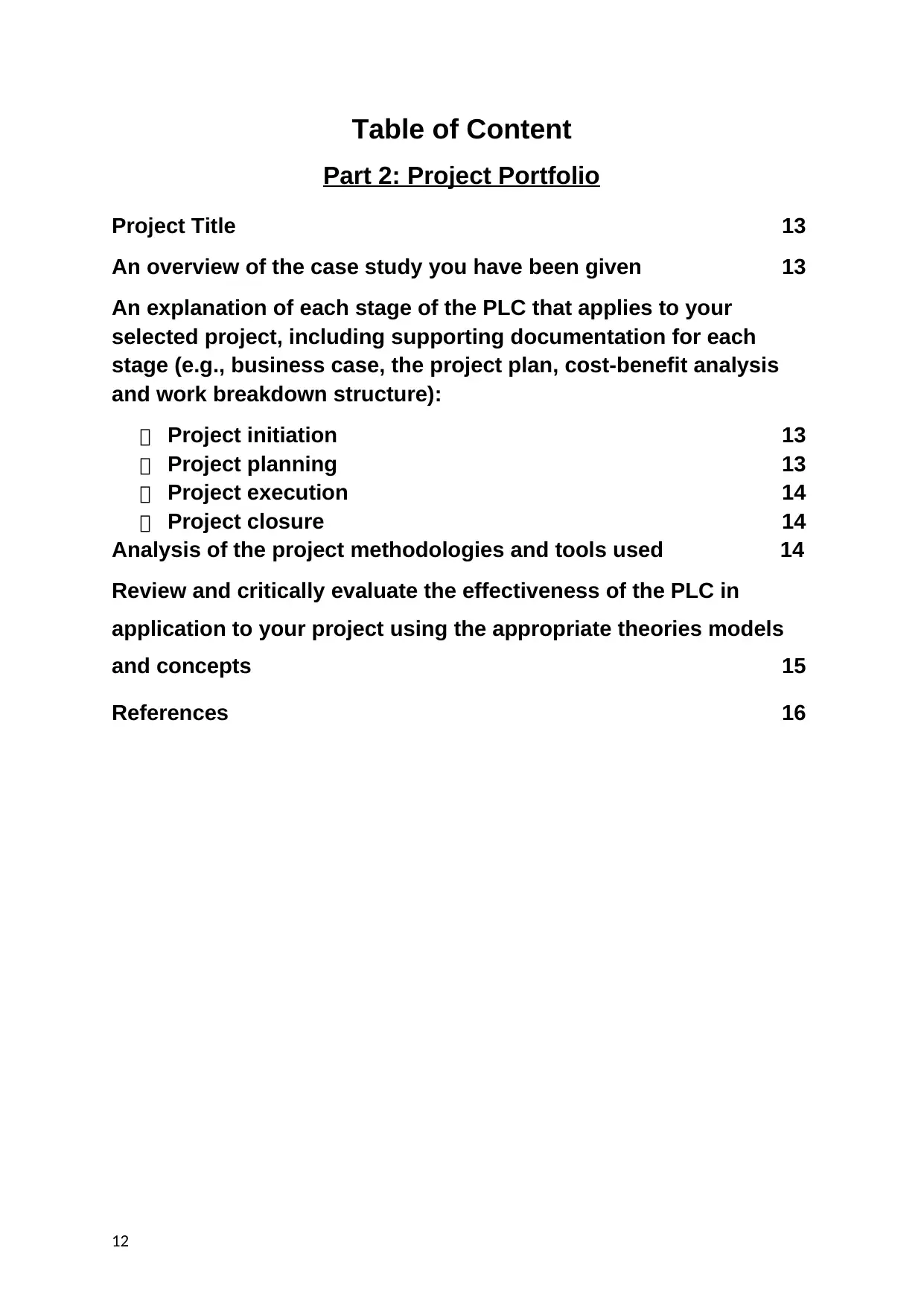
Table of Content
Part 2: Project Portfolio
Project Title 13
An overview of the case study you have been given 13
An explanation of each stage of the PLC that applies to your
selected project, including supporting documentation for each
stage (e.g., business case, the project plan, cost-benefit analysis
and work breakdown structure):
Project initiation 13
Project planning 13
Project execution 14
Project closure 14
Analysis of the project methodologies and tools used 14
Review and critically evaluate the effectiveness of the PLC in
application to your project using the appropriate theories models
and concepts 15
References 16
12
Part 2: Project Portfolio
Project Title 13
An overview of the case study you have been given 13
An explanation of each stage of the PLC that applies to your
selected project, including supporting documentation for each
stage (e.g., business case, the project plan, cost-benefit analysis
and work breakdown structure):
Project initiation 13
Project planning 13
Project execution 14
Project closure 14
Analysis of the project methodologies and tools used 14
Review and critically evaluate the effectiveness of the PLC in
application to your project using the appropriate theories models
and concepts 15
References 16
12
⊘ This is a preview!⊘
Do you want full access?
Subscribe today to unlock all pages.

Trusted by 1+ million students worldwide
1 out of 16
Related Documents
Your All-in-One AI-Powered Toolkit for Academic Success.
+13062052269
info@desklib.com
Available 24*7 on WhatsApp / Email
![[object Object]](/_next/static/media/star-bottom.7253800d.svg)
Unlock your academic potential
Copyright © 2020–2025 A2Z Services. All Rights Reserved. Developed and managed by ZUCOL.